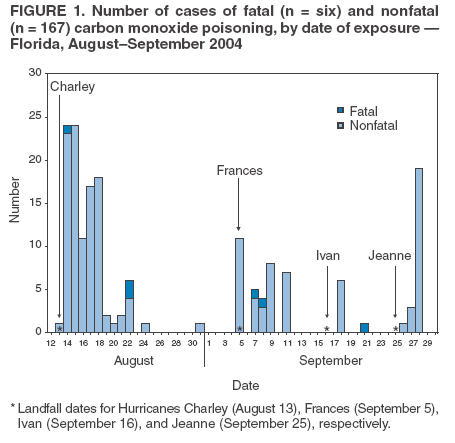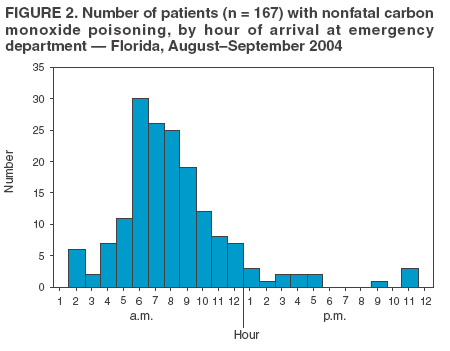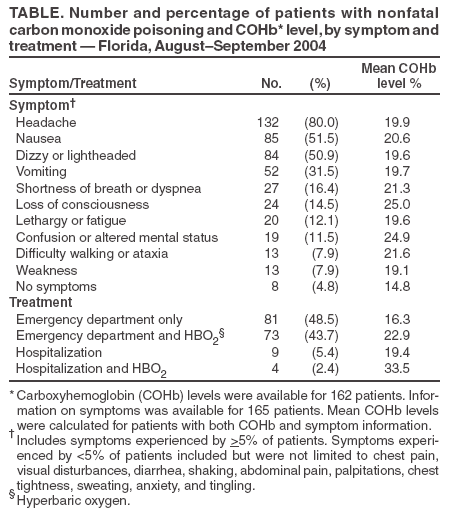 |
|
|
|
|
|
|
| ||||||||||
|
|
|
|
|
|
|
||||
| ||||||||||
|
|
|
|
|
Persons using assistive technology might not be able to fully access information in this file. For assistance, please send e-mail to: mmwrq@cdc.gov. Type 508 Accommodation and the title of the report in the subject line of e-mail. Carbon Monoxide Poisoning from Hurricane-Associated Use of Portable Generators --- Florida, 2004The four major hurricanes that struck Florida during August 13--September 25, 2004, produced electric power outages in several million homes (1). After the hurricanes, the Consumer Product Safety Commission (CPSC) investigated six deaths in Florida attributed to carbon monoxide (CO) poisoning (CPSC, unpublished data, 2004). The Florida Department of Health and CDC analyzed demographic and CO exposure data from these fatal poisoning cases and from nonfatal poisoning cases among 167 persons treated at 10 hospitals, including two with hyperbaric oxygen (HBO2) chambers. This report describes the results of that analysis, which determined that misplacement of portable, gasoline-powered generators (e.g., indoors, in garages, or outdoors near windows) was responsible for nearly all of these CO exposures. Public health practitioners should recognize that post-hurricane environments present challenges to the safe operation of portable generators and should educate the public on the hazards of CO poisoning in these settings. All medical records were reviewed from participating hospitals in which a patient received a diagnosis of unintentional CO poisoning (International Classification of Diseases, Ninth Revision code 986) during August 13--October 15, 2004. These dates correspond to landfall of the first hurricane (Charley) and 3 weeks after landfall of the last hurricane (Jeanne), when active surveillance for CO poisoning was discontinued. Nine participating hospitals, including one with an HBO2 chamber, were located in landfall counties and involved in post-hurricane surveillance; a tenth participating hospital, which also had an HBO2 chamber, was located in central Florida. Any case involving a diagnosis of unintentional CO poisoning not related to a fire was included. All available information about the patient's exposure, clinical presentation, laboratory testing (e.g., result of earliest available measurement of blood carboxyhemoglobin [COHb] level), and medical treatment was collected. In addition, investigations into six deaths from five exposure incidents were reviewed for basic demographic information and details about generator location. Because the six persons who were fatally poisoned died before arrival at a medical facility, no clinical information was recorded for them. A total of 167 persons had nonfatal CO poisoning diagnosed during the study period, representing a total of 51 exposure incidents. The number of cases and incidents peaked within 3 days after landfall of each hurricane (Figure 1). The mean number of persons poisoned per incident was 3.3 (range: one to eight persons per incident). Fifty-four (32.3%) patients were initially treated at emergency departments (EDs) in hospitals outside the surveillance system but were later transferred to one of the two hospitals with HBO2 chambers. Of the 167 persons with nonfatal poisoning, 87 (52.1%) were female. The median age was 29 years; 52 (31.1%) were aged <16 years, and 11 (6.6%) were aged >65 years. Seventy-six (45.5%) of the persons with nonfatal poisoning were white,* 47 (28.1%) Hispanic, 36 (21.6%) black, and six (3.6%) Asian; the race/ethnicity of two (1.2%) persons was not known. The percentages of those poisoned who were Hispanic and black were approximately twice the percentages of Hispanics (14.7%) and blacks (9.1%) reported residing in the hurricane-affected counties by the Florida 2004 Behavioral Risk Factor Surveillance System (BRFSS) survey. Among the six persons who were fatally poisoned, all were white, and five (83.3%) were male; the median age was 45 years (range: 30--58 years). The most frequently reported symptoms of CO poisoning were headache (80.0%), nausea (51.5%), dizziness (50.9%), vomiting (31.5%), shortness of breath (16.4%), and loss of consciousness (14.5%) (Table). Among the 162 patients for whom COHb levels were available, the mean level of COHb was 19.8% (standard deviation: +8.7%); median was 21.1% (range: 0.2%--45.1%). Eighty-one (48.5%) patients were treated and released from the ED without HBO2 treatment. Seventy-three (43.7%) patients were released after HBO2 treatment. Thirteen (7.8%) patients were hospitalized; 11 of those were discharged after one night. Of the 13 hospitalized patients, four received HBO2 treatment. Overall, 77 (46.1%) persons were treated with HBO2. The majority of nonfatal poisonings occurred overnight, with patients waking in the early morning with symptoms (Figure 2). One hundred eleven (66.5%) patients arrived at the ED during 5:00 a.m.--10:00 a.m. Medical records indicated that patients typically used generators to power refrigerators, fans, and air conditioners while sleeping. Similar exposure patterns and types of powered appliances were reported among the five incidents with fatalities. Information regarding the source of CO was available for 49 (96.1%) of the 51 incidents with nonfatal poisonings. Use of portable, gasoline-powered generators was implicated in 47 (96.0%) nonfatal incidents and in the five incidents that resulted in the six fatalities. In two other nonfatal incidents, exposure to CO was attributed to use of a gasoline-powered saw and to a vehicle left idling in a garage. In the 47 nonfatal incidents in which a generator was known to be involved, 16 (34.0%) generators were operated outdoors; 16 (34.0%) inside a garage; six (12.8%) inside a home; four (8.5%) on an attached porch, deck, or patio; one (2.1%) inside a business; and one (2.1%) as part of a recreational vehicle. Generator location was unavailable for three (6.4%) incidents. The majority of the 16 generators placed outdoors were reportedly located near windows or window-mounted air conditioners. Medical records for certain patients indicated that generators were placed in homes or garages to protect the devices from the weather or to prevent them from being stolen. Among the five incidents with fatalities, generators were placed inside a home in two incidents, in an office or business in two incidents, and inside a garage in one incident. No mention was made of a home CO detector in any of the medical records. Reported by: JC Sniffen, DO, TW Cooper, MD, Florida Hospital, Orlando; D Johnson, MD, C Blackmore, DVM, P Patel, MD, L Harduar-Morano, MPH, Div of Environmental Health; R Sanderson, MA, A Ourso, MPH, K Granger, MPH, Bur of Epidemiology, Florida Dept of Health. J Schulte, DO, National Center for Health Marketing; JM Ferdinands, PhD, RL Moolenaar, MD, K Dunn, MS, S Damon, MAIA, Div of Environmental Hazards and Health Effects, National Center for Environmental Health; D Van Sickle, PhD, D Chertow, MD, EIS officers, CDC. Editorial Note:Portable, gasoline-powered generators are a common source of unintentional CO poisoning after power outages (2). The devices are used increasingly to provide electricity during temporary outages resulting from adverse weather events, but the CO produced during their operation can be a serious health hazard. The exhaust produced by the typical 5.5 kW generator contains as much CO as that of six idling automobiles (2,3). When used indoors or in close proximity to residential dwellings, this exhaust can quickly infiltrate living spaces and incapacitate occupants (2). Data from the 2004 BRFSS indicate that 17.5% of adult respondents in Florida reported that their household used a generator for power after at least one of the hurricanes; a substantial number of these generators were operated inside a home or garage (4). This report demonstrates that CO poisoning, although not perceived as an important health problem by the public (4), represents an important cause of morbidity and mortality in a post-hurricane environment. In this study, portable generators were the source of CO for all fatal cases and nearly all nonfatal cases of CO poisoning. Misplacement of portable generators indoors, in garages, or outdoors near windows accounted for most exposures. In addition, the majority of CO exposures occurred during overnight use of generators to power air conditioners and appliances. The findings in this report are subject to at least three limitations. First, investigators used a sample of 10 hospitals to collect cases of CO poisoning; therefore, the findings are not a complete inventory of cases of CO poisoning in Florida during the 2004 hurricane season. Second, only cases of CO poisoning among persons treated at hospital EDs and at two HBO2 chambers were included in the study; therefore, the results likely reflect more severe poisonings than would occur in a general population. Finally, because the study was limited to data documented in hospital records, the role of previously identified risk factors (e.g., language barriers) (5) was not examined in these cases of CO poisoning. Sales of portable generators have been increasing since 2000 (6), primarily because of increased affordability of the devices and disaster preparedness campaigns. With increasing numbers of new generator owners, public health officials can expect a decline in the mean level of user experience with the devices. An above-normal hurricane season was predicted for 2005, with 12--15 tropical storms (average: 10), including seven to nine hurricanes (average: six), with three to five (average: two) of these rated as major (category 3--5) hurricanes. The majority of the storms were expected to form during August--October (7). However, as of July 14, the season had already produced five tropical storms, including two that became major hurricanes. Power outages that occur after hurricanes create demand for alternate electricity sources to power air conditioning, ventilation, and refrigeration. The urgent need for interim power supplies, coupled with fear of theft and the risks of shock and electrocution posed by using nonweatherized devices in wet conditions, create challenges to the safe operation of portable generators in post-hurricane settings. Nonetheless, public health campaigns should emphasize that portable generators must never be operated indoors, in garages, or outdoors anywhere near doors, windows, or vents of buildings that might be occupied. Acknowledgment This report is based, in part, on data contributed by CPSC. References
* For this report, persons identified as white, black, and Asian are all non-Hispanic. Persons identified as Hispanic might be of any race.
Figure 1  Return to top. Figure 2  Return to top. Table  Return to top.
Disclaimer All MMWR HTML versions of articles are electronic conversions from ASCII text into HTML. This conversion may have resulted in character translation or format errors in the HTML version. Users should not rely on this HTML document, but are referred to the electronic PDF version and/or the original MMWR paper copy for the official text, figures, and tables. An original paper copy of this issue can be obtained from the Superintendent of Documents, U.S. Government Printing Office (GPO), Washington, DC 20402-9371; telephone: (202) 512-1800. Contact GPO for current prices. **Questions or messages regarding errors in formatting should be addressed to mmwrq@cdc.gov.Date last reviewed: 7/20/2005 |
|||||||||
|